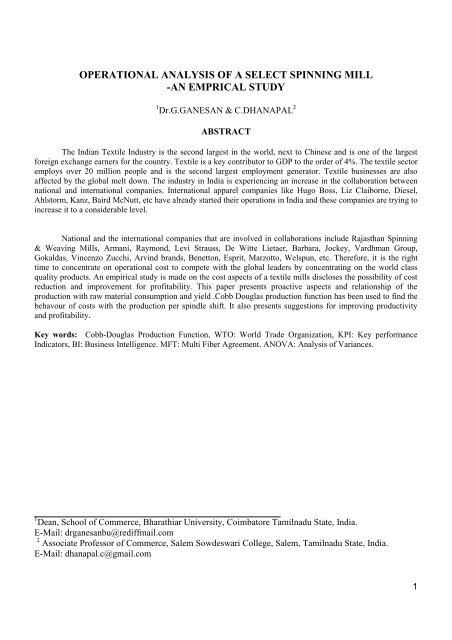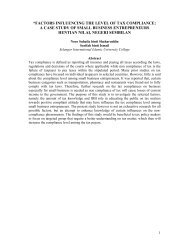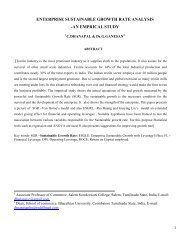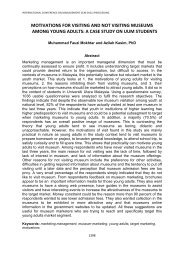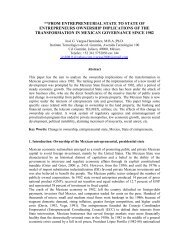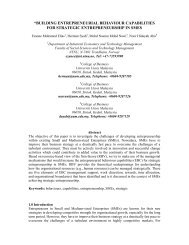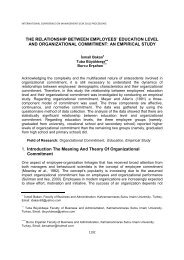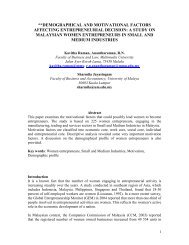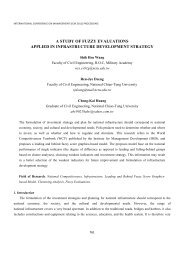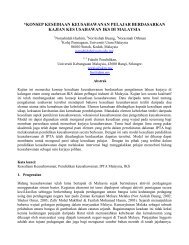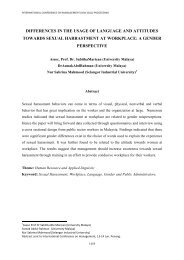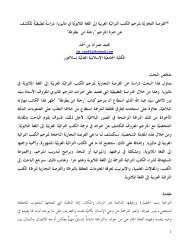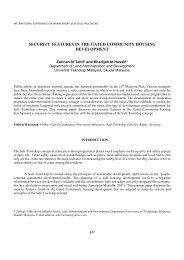operational analysis of a select spinning mill - International ...
operational analysis of a select spinning mill - International ...
operational analysis of a select spinning mill - International ...
You also want an ePaper? Increase the reach of your titles
YUMPU automatically turns print PDFs into web optimized ePapers that Google loves.
OPERATIONAL ANALYSIS OF A SELECT SPINNING MILL<br />
-AN EMPRICAL STUDY<br />
1 Dr.G.GANESAN & C.DHANAPAL 2<br />
ABSTRACT<br />
The Indian Textile Industry is the second largest in the world, next to Chinese and is one <strong>of</strong> the largest<br />
foreign exchange earners for the country. Textile is a key contributor to GDP to the order <strong>of</strong> 4%. The textile sector<br />
employs over 20 <strong>mill</strong>ion people and is the second largest employment generator. Textile businesses are also<br />
affected by the global melt down. The industry in India is experiencing an increase in the collaboration between<br />
national and international companies. <strong>International</strong> apparel companies like Hugo Boss, Liz Claiborne, Diesel,<br />
Ahlstorm, Kanz, Baird McNutt, etc have already started their operations in India and these companies are trying to<br />
increase it to a considerable level.<br />
National and the international companies that are involved in collaborations include Rajasthan Spinning<br />
& Weaving Mills, Armani, Raymond, Levi Strauss, De Witte Lietaer, Barbara, Jockey, Vardhman Group,<br />
Gokaldas, Vincenzo Zucchi, Arvind brands, Benetton, Esprit, Marzotto, Welspun, etc. Therefore, it is the right<br />
time to concentrate on <strong>operational</strong> cost to compete with the global leaders by concentrating on the world class<br />
quality products. An empirical study is made on the cost aspects <strong>of</strong> a textile <strong>mill</strong>s discloses the possibility <strong>of</strong> cost<br />
reduction and improvement for pr<strong>of</strong>itability. This paper presents proactive aspects and relationship <strong>of</strong> the<br />
production with raw material consumption and yield .Cobb Douglas production function has been used to find the<br />
behavour <strong>of</strong> costs with the production per spindle shift. It also presents suggestions for improving productivity<br />
and pr<strong>of</strong>itability.<br />
Key words: Cobb-Douglas Production Function, WTO: World Trade Organization, KPI: Key performance<br />
Indicators, BI: Business Intelligence. MFT: Multi Fiber Agreement. ANOVA: Analysis <strong>of</strong> Variances.<br />
1 Dean, School <strong>of</strong> Commerce, Bharathiar University, Coimbatore Tamilnadu State, India.<br />
E-Mail: drganesanbu@rediffmail.com<br />
2 Associate Pr<strong>of</strong>essor <strong>of</strong> Commerce, Salem Sowdeswari College, Salem, Tamilnadu State, India.<br />
E-Mail: dhanapal.c@gmail.com<br />
1
1. INTRODUCTION<br />
The Indian textile industry, until the economic liberalization <strong>of</strong> Indian economy was<br />
predominantly an unorganized industry. The economic liberalization <strong>of</strong> Indian economy in the<br />
early 1990s led to stupendous growth <strong>of</strong> this Indian industry. Now Textile industry is the most<br />
prominent industry in India as it supplies cloth to the populations. It also assists for the survival<br />
<strong>of</strong> other small scale industries. Textile industry has shown its major growth in the post quota<br />
regime under the WTO agreement. Textile accounts for 14% <strong>of</strong> the total Industrial production<br />
and contributes nearly 30% <strong>of</strong> the total exports. Textile is a key contributor to GDP to the order<br />
<strong>of</strong> 4%. The intense global competition in textiles has stimulated cost-cutting measures and new<br />
investments that have significantly increased the efficiency <strong>of</strong> transforming cotton fiber into<br />
yarn. Continuous improvement in production, waste reduction and productivity would<br />
automatically lead <strong>of</strong> success <strong>of</strong> the enterprise.<br />
The Spinning Industry in India is on set to hit the global market with other fabrics as well<br />
like the cotton textiles with its enthusiasm and consistency in work. It has already reached a<br />
phenomenal status in India by beating the obstacles that caused a downfall since past few years<br />
and is now on its way to cover a wider area in the <strong>spinning</strong> sector.<br />
2. STATEMENT OF THE PROBLEM<br />
Indian Spinning Industry has gone from strength to strength since a very long time now as it<br />
was the hub <strong>of</strong> cotton manufacturing. Cotton is not only consumed to the highest extent in India<br />
but it has also become one <strong>of</strong> the most pr<strong>of</strong>itable textiles in the export industry. The productivity<br />
in case <strong>of</strong> <strong>spinning</strong> <strong>mill</strong> is confined to gms per spindle shift. An elaborate and detailed<br />
assessment is made on various sectors <strong>of</strong> the yarn <strong>spinning</strong> such as, production, consumption,<br />
and materials. Everyone should try to get increased production at the least possible cost.<br />
For this purpose it is necessary to find the behaviour <strong>of</strong> the production, raw material and<br />
yield .Tuning this well would enhance the productivity. On the other hand the costs associated<br />
with the production should also be evaluated to achieve the production with the least possible<br />
costs. It is necessary for everyone to improve productivity as well as pr<strong>of</strong>itability for their<br />
survival in the global economic crisis. It is right time to find solution to this type <strong>of</strong> problems.<br />
__________________________________________<br />
1 Dean, School <strong>of</strong> Commerce, Bharathiar University, Coimbatore Tamilnadu State, India.<br />
E-Mail: drganesanbu@rediffmail.com<br />
2 Associate Pr<strong>of</strong>essor <strong>of</strong> Commerce, Salem Sowdeswari College, Salem. Tamilnadu State, India. E-Mail:<br />
dhanapal.c@gmail.com<br />
2
3. OBJECTIVES OF STUDY<br />
The following may be taken as the objectives <strong>of</strong> the study:<br />
3.1. To find the relationship between production and raw material consumption and yield.<br />
3.2. To find the association between Spinning production and costs.<br />
3.3. To predict the <strong>spinning</strong> production using Cobb Douglas production function.<br />
3.4. To <strong>of</strong>fer plausible suggestions for improvement in cost and efficiency.<br />
4. REVIEW OF LITERATURE<br />
1 Imran Sharif Chaudhry et al (2009) have made study on “Factors Affecting Cotton<br />
Production in Pakistan: Empirical Evidence from Multan District”. They examined the factors<br />
affecting cotton production. In that study Cobb-Douglas Production Function was used to assess<br />
the effects <strong>of</strong> various inputs like cultivation, seed and sowing, irrigation, fertilizer, plant<br />
production and labour cost on yield.<br />
2 Moosup Jung, et al (2008) made a study on” Total Factor Productivity <strong>of</strong> Korean Firms<br />
and Catching up with the Japanese firms “.They measured and compared the TFP <strong>of</strong> both<br />
Korean and Japanese listed firms <strong>of</strong> 1984 to 2004.They used the Chain Linked Index Number<br />
method developed by Good et. al.(1999). They found that the average TFP <strong>of</strong> Korean firms grew<br />
about 44.1% between 1984 and 2005, with 2.1% annual growth rates. Industry was observed to<br />
be outstanding.<br />
3 Danish A. Hashim made research on” Cost and Productivity in Indian Textiles” for<br />
Indian Council for Research on <strong>International</strong> Economic Relations. His observations and findings<br />
are: There is an inverse relationship between the unit cost and productivity: Industry and States,<br />
which witnessed higher productivity (growth) experienced lower unit cost (growth) and vice -<br />
versa. Better capacity utilization, reductions in Nominal Rate <strong>of</strong> Protection and increased<br />
availability <strong>of</strong> electricity are found to be favourably affecting the productivity in all the three<br />
industries.<br />
___________________________________<br />
1 Imran Sharif Chaudhry, Muhammad Bashir Khan ( Bahauddin Zakariya University Multan,Pakistan )<br />
and Mumtaz Anwar(University <strong>of</strong> the Punjab, Lahore, Pakistan)-“ Factors Affecting Cotton Production<br />
in Pakistan: Empirical Evidence from Multan District”- Journal <strong>of</strong> Quality and Technology Management,<br />
Volume V, Issue I1, Dec, 2009, pg. 91-100.<br />
2 Moosup Jung, Keun Lee( School <strong>of</strong> Economics, Seoul National University korea) and Kyoji Fukao<br />
(Hitoshubashi University, Japan )- Total Factor Productivity <strong>of</strong> Korean Firms and Catching up with the<br />
Japanese firms- Seoul Journal <strong>of</strong> Economics, vol 20,no 1, March 2008.<br />
Gokhale 1992 in Cotton Mill Sector', Productivity, January- March.<br />
3 Danish A. Hashim (2004)- cost and productivity in Indian Textiles- Indian Council For Research On<br />
<strong>International</strong> Economic Relations. Multan District” Journal <strong>of</strong> Quality and Technology Management,<br />
Volume V, Issue I1, Dec, 2009, pg. 91-100<br />
3
4 Gokhale, G S (1992) an important factor that affects material productivity is the quality<br />
<strong>of</strong> cotton that is used to produce a particular kind <strong>of</strong> yarn or cloth. Using too good a cotton<br />
variety would contribute to excessive cost, but using cotton that is not good enough would mean<br />
increased breakage, a heavier work load for the worker, who consequently can only attend to a<br />
lesser number <strong>of</strong> machine units. The material productivity is influenced by a number <strong>of</strong> factors<br />
such as quality <strong>of</strong> material used, type <strong>of</strong> technology used, level <strong>of</strong> maintenance and life <strong>of</strong><br />
machinery, count produced and the like.<br />
5 Productivity also depends upon such factors as layout <strong>of</strong> machines, mechanical transport<br />
for material handling and machine maintenance. As a result <strong>of</strong> all these factors, productivity <strong>of</strong><br />
the worker is largely governed by a proper machine allocation. This can easily be determined by<br />
work-study.<br />
6 SITRA (1998) stated that the size <strong>of</strong> the <strong>mill</strong>s decides the volume <strong>of</strong> business and also the<br />
economic viability <strong>of</strong> the business unit. Selection <strong>of</strong> suitable size is important for smooth conduct<br />
<strong>of</strong> business, over-capacity as well as under- capacity would bring pressure on the business.<br />
5. SIGNIFICANCE OF THE STUDY<br />
The new textile policy is to be seen in the backdrop <strong>of</strong> fast changing international<br />
scenario in the post-.GATT era and its implications on Indian textile sector. Textile and clothing<br />
have been brought within the framework <strong>of</strong> GATT in the Uruguay round <strong>of</strong> the multilateral trade<br />
negotiations. The first impact <strong>of</strong> this negotiation would be felt by the Indian textile industry after<br />
the expiry <strong>of</strong> Multi Fiber Agreement (MFA) on December 31, 2004. Expiry <strong>of</strong> MFA would have<br />
implications on both inter-national as well as domestic markets. The Indian textile industry has to<br />
be globally competitive to be able to sustain its presence not only in the international market but<br />
also in the domestic.<br />
On the other side technological capability is embodied in the human and physical capital<br />
in command <strong>of</strong> the industry. In a dynamic sense it means the ability <strong>of</strong> the industry to articulate<br />
its business problems in terms <strong>of</strong> technology and also the ability to access human, physical,<br />
financial and organizational resources to find solutions to the articulated technological problems.<br />
_______________________________________________<br />
4 Gokhale, G S (1992) 'The Role <strong>of</strong> Productivity in Cotton Mill Sector', Journal <strong>of</strong> Productivity, January-<br />
March.<br />
5 Porter, Michael (1992): Quoted in G S Gokhale, 'Role <strong>of</strong> Productivity in Cotton Textile Mill Industry',<br />
Productivity, Vol 33, No 1 April- June.<br />
6 SITRA (1998): 'Productivity Performance in Spinning', SITRA Publication, South Indian Cotton Textile<br />
Research Association, Coimbatore, p 4.<br />
4
6. METHODOLOGY:<br />
Comprehensive research work was done to achieve the objectives <strong>of</strong> the study. Ten year<br />
data - 1998-99 to 2007-08 <strong>of</strong> Sambandam Spinning Mills Salem has been employed for this<br />
study. In the first step the association between productions, raw material consumption and yield<br />
are arrived by employing the multiple regressions. In the next step the relationship between<br />
<strong>spinning</strong> production per spindle shift and related costs per spindle shifts are arrived by using the<br />
Cobb Douglass production function. Based on this <strong>spinning</strong> production per spindle shifts are<br />
estimated and the production achievements are compared between the two units <strong>of</strong> the same<br />
company.<br />
Statistical tools such as Regressions, Analysis <strong>of</strong> variance technique has been employed<br />
to the test the hypotheses.<br />
6.1. DATA ANALYSIS:<br />
The data related to the two units <strong>of</strong> SSM Ltd has been analyzed towards its production<br />
and <strong>operational</strong> costs. The following table shows the production, raw material consumption and<br />
yield <strong>of</strong> SSM Ltd Unit-1 and Unit-2 for 10 years from 1998-99 to 2007-08.<br />
Table No: 1 Production, Raw Material Consumption and Yield<br />
SSM LTD –UNIT-1<br />
Production<br />
(in-akh<br />
Kgs)<br />
Raw material<br />
Consumed<br />
(in-Lakh Kgs)<br />
Production<br />
(in-Lakh<br />
Kgs)<br />
SSM LTD –UNIT-2<br />
Rawmaterial<br />
Consumed<br />
(in-Lakh<br />
Kgs)<br />
Yield<br />
(Ratio)<br />
1998-99 20.33 26.38 0.77 21.58 32.18 0.67<br />
1999-00 19.27 26.60 0.72 19.54 30.49 0.64<br />
2000-01 19.19 26.12 0.73 18.56 29.02 0.64<br />
2001-02 19.19 26.12 0.73 18.08 28.31 0.64<br />
2002-03 18.00 24.38 0.74 19.41 28.08 0.69<br />
2003-04 17.52 22.90 0.77 25.10 36.18 0.69<br />
2004-05 20.91 26.45 0.79 23.90 36.97 0.65<br />
2005-06 20.98 27.03 0.78 24.35 37.55 0.65<br />
2006-07 19.25 30.63 0.63 27.65 41.78 0.66<br />
2007-08 26.55 40.28 0.66 29.59 45.09 0.66<br />
Yield<br />
(Ratio)<br />
The following hypotheses have been framed to test the relationship between production and costs<br />
<strong>of</strong> the two units.<br />
HYPOTHESIS.1:<br />
THERE IS NO SIGNIFICANT RELATIONSHIP BETWEEN YARN PRODUCTION,<br />
RAW MATERIAL CONSUMPTION AND YIELD RATIO OF SSM LTD UNIT-1.<br />
To study the significant relationship between the yarn production, raw material<br />
consumption and yield ratio multiple regression <strong>analysis</strong> is employed.. Here we take the yarn<br />
production as dependent variable and other factors as independent variables. The following<br />
table shows the results <strong>of</strong> fitting a multiple linear regression model:<br />
5
Graph 1<br />
RAWMATERIAL CONSUMPTION AND PRODUCTION OF<br />
SSMLTD UNIT-1 AND UNIT-2<br />
In Lakh Kgs.<br />
50<br />
45<br />
40<br />
35<br />
30<br />
25<br />
20<br />
15<br />
10<br />
5<br />
0<br />
45.09<br />
41.78<br />
40.28<br />
36.18 36.97 37.55<br />
32.18<br />
30.49<br />
30.63<br />
29.02 28.31<br />
26.38 26.6<br />
28.08<br />
26.12 26.12<br />
26.45 27.03<br />
26.55<br />
24.38<br />
22.9<br />
20.33<br />
20.91 20.98<br />
19.27 19.19 19.19<br />
19.25<br />
18 17.52<br />
1998-99 1999-00 2000-01 2001-02 2002-03 2003-04 2004-05 2005-06 2006-07 2007-08<br />
YEAR<br />
S1.Production S1.Rawmaterial S2.Production S2.Raw- material<br />
Table .2<br />
Coefficients:<br />
Standard<br />
Parameter Estimate Error Statistic P-Value<br />
CONSTANT -18.4159 1.76891 -10.4109 0.0000<br />
Raw material consumption 0.673339 0.0197851 34.0326 0.0000<br />
Yield 27.1733 1.84076 14.762 0.0000<br />
The fitted multiple regression models involving the explanatory variables are given<br />
below:<br />
PRODUCTION = -18.4159 + 0.673339*RAW MATERIAL CONSUMPTION +<br />
27.1733*YIELD.<br />
From the model it is observed that there is a positive relationship between yarn<br />
production and raw material consumption. It shows that yarn production would increase by 0.67<br />
units, if the raw material consumption increases by 1 unit assuming the yield remains the same.<br />
It also shows that there is a positive relationship between yield and yarn production. That is<br />
the yarn production would increase by 27 units if the yield increases by 1 unit assuming the<br />
consumption remains the same.<br />
T<br />
6
The validity <strong>of</strong> the model has been tested by ANOVA. The output <strong>of</strong> the ANOVA is<br />
presented as :<br />
Table No.3 - Analysis <strong>of</strong> Variance<br />
Source Sum <strong>of</strong> Squares Df Mean Square F-Ratio P-Value<br />
Model 56.9084 2 28.4542 646.83 0.0000<br />
Residual 0.307931 7 0.0439901<br />
Total (Corr.) 57.2163 9<br />
Since the P-value in the ANOVA table is less than 0.05, there is a statistically significant<br />
relationship between the variables at the 95.0% or higher confidence level. Hence fitted model<br />
is the most suitable model to describe the relationships <strong>of</strong> the variables.<br />
Table.4. Related Statistics<br />
R2<br />
Standard<br />
Mean Absolute Error Dubin-Watson Statistics<br />
Error <strong>of</strong> Estimate<br />
99.4618 percent 0.209738 0.136684 1.30309(P=0.0942)<br />
The R-Squared statistic indicates that the model as fitted explains 99.4618%<strong>of</strong> the<br />
variability in production. The standard error <strong>of</strong> the estimate shows the standard deviation <strong>of</strong> the<br />
residuals to be 0.209738.<br />
The mean absolute error (MAE) <strong>of</strong> 0.136684is the average value <strong>of</strong> the residuals. The<br />
Durbin-Watson (DW) statistic tests the residuals to determine if the re is any significant<br />
correlation based on the order in which they occur. Since the P-value is greater than 0.05, there is<br />
no indication <strong>of</strong> serial autocorrelation in the residuals at the 95.0% confidence level.<br />
HYPOTHESIS.2:<br />
THERE IS NO SIGNIFICANT REATIONSHIP BETWEEN YARN PRODUCTION, RAW<br />
MATERIAL CONSUMPTION AND YIELD RATIO OF SSM LTD UNIT-2<br />
To study the Significant Relationship between the Yarn Productions, Raw Material<br />
Consumption and yield ratio multiple regression <strong>analysis</strong> is employed. Here we take the yarn<br />
production as dependent variable and other factors as independent variables. The following<br />
table shows the results <strong>of</strong> fitting a multiple linear regression model:<br />
7
Table 5<br />
Coefficients:<br />
Standard T<br />
Parameter Estimate Error Statistic P-Value<br />
CONSTANT -20.9637 0.963011 -21.7689 0.0000<br />
s2rawmaterial consumption 0.657836 0.00502045 131.031 0.0000<br />
s2yield 31.8798 1.45079 21.9741 0.0000<br />
The fitted multiple regression models involving the explanatory variables are given below:<br />
S2YARN-PRODUCTION = -20.9637 + 0.657836*S2RAWMATERIAL CONSUMPTION +<br />
31.8798*S2YIELD.<br />
From the model it is observed that there is a positive relationship between yarn<br />
production and raw material consumption. It shows that yarn production would increase by 0.66<br />
units, if the raw material consumption increases by 1 unit assuming the yield remains the same.<br />
It also shows that there is a positive relationship between yield and yarn production. That is the<br />
yarn production would increase by 31.88 units if the yield increases by 1 unit assuming the raw<br />
material consumption remains the same. The validity <strong>of</strong> the model has been tested by ANOVA.<br />
The output <strong>of</strong> the ANOVA is presented as :<br />
Table No.6<br />
Analysis <strong>of</strong> Variance<br />
Source Sum <strong>of</strong> Squares Df Mean Square F-Ratio P-Value<br />
Model 142.31 2 71.1552 8996.15 0.0000<br />
Residual 0.0553666 7 0.00790951<br />
Total (Corr.) 142.366 9<br />
Since the P-value in the ANOVA table is less than 0.05, there is a statistically significant<br />
relationship between the variables at the 95.0% or higher confidence level. Hence fitted model<br />
is the most suitable model to describe the relationships <strong>of</strong> the variables.<br />
Table .7-Related Statistics<br />
R2<br />
Standard<br />
Mean Absolute Error Dubin-Watson Statistics<br />
Error <strong>of</strong> Estimate<br />
99.9611 percent 0.0889355 0.0593909 3.17366 (P=0.9427)<br />
The R-Squared statistic indicates that the model as fitted explains 99.9611% <strong>of</strong> the<br />
variability in production. The standard error <strong>of</strong> the estimate shows the standard deviation <strong>of</strong> the<br />
residuals to be 0.0889355. The mean absolute error (MAE) <strong>of</strong> 0.0593909 is the average value <strong>of</strong><br />
the residuals. The Durbin-Watson (DW) statistic tests the residuals to determine if there is any<br />
significant correlation based on the order in which they occur. Since the P-value is greater than<br />
0.05, there is no indication <strong>of</strong> serial autocorrelation in the residuals at the 95.0% confidence level<br />
COBB DOUGLAS PRODUCTION FUNCTION:<br />
Generally for the same level <strong>of</strong> input factors, everyone should get almost the same level<br />
<strong>of</strong> output. In <strong>spinning</strong> <strong>mill</strong>s the production and cost related to the <strong>spinning</strong> department has been<br />
considered as the important indicator <strong>of</strong> the <strong>operational</strong> performance. Therefore production and<br />
cost related to the <strong>spinning</strong> department has been taken for the <strong>analysis</strong>. To test production<br />
achievement <strong>of</strong> the companies, the Cobb-Douglas Production Function is employed. The Cobb-<br />
8
Douglas Production Function assess the effects <strong>of</strong> various inputs like raw material, labour store<br />
cost, power, interest, depreciation and other costs involved in the production <strong>of</strong> yarn. The log<br />
linear form <strong>of</strong> production function used is based on the following equation.<br />
LnY =α+β1LnX1+ β2LnX2 + β3LnX3+ β4LnX4 + β5LnX5 + β6LnX6 + β7 LnX7 +uµ<br />
Where,<br />
Ln Y = Dependent Variable –Spinning production per Spindle shift.<br />
X1= Xn are independent variables;<br />
X1 = Raw Material cost /Spindle shift; X2 = Salaries and Wages/spindle shift<br />
X3= Stores cost / Spindle shift; X4 = Power cost / Spindle shift<br />
X5 = Other costs/ spindle shift; X6 = Interest cost/ spindle shift<br />
X7 = Depreciation cost/ spindle shift<br />
α = constant /Intercept.<br />
β = co-efficient;<br />
u =Random disturbance term;<br />
Ln = Natural Logarithms.<br />
To predict the production, first <strong>of</strong> all the dependent and independent variables are to be<br />
fixed in the production function equation and processed to get constants and co efficient. To<br />
arrive this following steps are carried out.<br />
In the first step data related to the production function as given in the following tables<br />
have been applied in the multiple regression models after converting the same in its log form to<br />
arrive the constants and coefficients. In the second step the resultant constants and coefficients<br />
are applied in the Cobb Douglas production function to estimate the production. In the third step<br />
the ten year averages <strong>of</strong> independent variables <strong>of</strong> all the four companies have been calculated. In<br />
the fourth step such average cost is applied in the production function along with the constants<br />
and co-efficient to predict the production <strong>of</strong> each company to evaluate the production<br />
achievement <strong>of</strong> the companies. The following table shows the unit wise constants and<br />
coefficients variables related to the production function.<br />
Table 8.<br />
Constants and Coefficients –SSM Ltd Unit-1 and Unit-2<br />
COMPANY SSM-UNIT-1 SSM-UNIT-2<br />
CONSTANTS 3.66 3.92<br />
CO-EFFICIENTS<br />
Mat. cost /sple sft 0.21 0.72<br />
S& Wages/sple sft -0.06 0.29<br />
Stores/Sple Sft -0.08 0.36<br />
Power/Sple Sft 0.77 -0.83<br />
Other costs/Sple Sft -0.51 1.77<br />
Interest/Sple Sft -0.29 -0.5<br />
Dep/Sple Sft 0.01 0.93<br />
The regression equation for SSM LTD UNIT-1 is given below:<br />
Ssm-1.pdnpersplesft = 3.6585 + 0.206866*ssm-1.rawpersft - 0.0619988*ssm-<br />
1.swpersplesft - 0.0816154*ssm-1.storpersplesft + 0.773897*ssm-1.powerpersplesft -<br />
0.510007*ssm-1.otherpersplesft - 0.287602*ssm-1.intpersplesft + 0.0112882*ssm-<br />
1.deppersplesft.<br />
9
It shows that there is a positive relationship between production per spindle shifts and raw<br />
material cost, power cost and depreciation. That is the production per spindle shift increases by<br />
the respective co-efficient level if the raw material, power and depreciation increases by one unit<br />
assuming the other variables remain constant.<br />
Similarly the equation shows negative relationship between production per spindle shifts<br />
and salaries and wages, stores, other cost and interest cost. That is the production per spindle<br />
shift decreases by the respective co-efficient level if salaries and wages, stores, other cost and<br />
interest cost decreases by one unit assuming the other variables remain constant.<br />
The regression equation for SSM LTD UNIT-2 is given below:<br />
pdnpersplesft = 3.92029 + 0.71877*rawpersft + 0.294551*swpersplesft +<br />
0.361561*storpersplesft - 0.833235*powerpersplesft + 1.7669*otherpersplesft -<br />
0.497305*intpersplesft + 0.933198*deppersplesft<br />
.<br />
It shows that there is a positive relationship between production per spindle shifts and raw<br />
material cost, salaries and wages, stores, other costs and depreciation. That is the production per<br />
spindle shift increases by the respective co-efficient level if the raw material cost, salaries and<br />
wages, stores, other costs and depreciation by one unit assuming the other variables remain<br />
constant.<br />
Similarly the equation shows negative relationship between production per spindle shifts<br />
and power cost and interest cost. That is the production per spindle shift decreases by the<br />
respective co-efficient level if power cost and interest cost decreases by one unit assuming the<br />
other variables remain constant.<br />
Table 9<br />
PREDICTED PRODUCTION--COBB-DOUGLAS PRODUCTION FUNCTION<br />
COMPANY SSM-UNIT-1 SSM-UNIT-2<br />
PREDICTED PRODUCTION<br />
1 Gms/Sple Sft 112.45 109.4<br />
COST-APPLIED<br />
Average uniform cost applied<br />
2 Mat.cost/Sple Sft 7.08 7.08<br />
3 S& Wages/ Sple Sft 0.89 0.89<br />
4 Stores/Sple sft 0.28 0.28<br />
5 Power/Sple sft 2.21 2.21<br />
6 Other costs/sple sft 1.43 1.43<br />
7 Interest/sple sft 0.67 0.67<br />
8 Dep/sple sft 0.72 0.72<br />
9 Total Cost /Sple Shift 13.28 13.28<br />
10 Cost per Gms 0.1181 0.1214<br />
11 RANKS-Production 1 2<br />
12<br />
Spindle Shifts-one day ( assuming<br />
25,000 spindle and 3 shift working) 75000 75000<br />
13 predicted production –One day 8434 8205<br />
14 Total Costs-one Day 996000 996000<br />
15 cost per kg 118 121<br />
10
It has been observed that predicted production differs within the units <strong>of</strong> the same<br />
company. The production achievement ranks given .It also shows that increased production<br />
causes reduction in cost<br />
7. FINDINGS<br />
The following are finding arrived from the data <strong>analysis</strong>:<br />
1. The yarn production depends on the raw material input and yield percentage. The data<br />
have been tested with the multiple regression <strong>analysis</strong>. It shows that there is a significant<br />
association between the Production, raw material consumption and yield ratio.<br />
2. The Cobb Douglass production function shows the relationship between production per<br />
spindle shift and various component costs per spindle shifts. Prediction <strong>of</strong> production is made<br />
based on the co-efficient and constants arrived from the regression equation. It shows that there<br />
is a difference in production though the same uniform costs are applied. The table also shows the<br />
one day production and respective costs and also the cost per Kg. The cost per kg in SSM Ltd<br />
Unit-1 is lesser because <strong>of</strong> greater production per spindle shift.<br />
8. SUGGESTIONS<br />
The following strategies may help the Textile Mills to meet the global challenges to grow<br />
up as a global leader by improving the pr<strong>of</strong>itability:<br />
1. Buy high yield raw cottons after testing the samples. Cottons without contamination would<br />
give more yields. Before going for production the cotton has to be tested for its yield and then<br />
order for raw materials. This would increase the productivity.<br />
2. Reduction in cost per machine shift would reduce the cost <strong>of</strong> manufacturing. Monitor the costs<br />
by applying activity based costing and remove the unnecessary activities and save the costs.<br />
3. Increase the spindle utilization and make spin plan before starting the production so that count<br />
change, count run outs and other reasons for spindle stoppage may be reduced to optimize the<br />
spindle utilization.<br />
4. Interest Charges: Due to the injection <strong>of</strong> more debt funds heavy interest charges occurs. Mills<br />
are unable to use debt funds to magnify the pr<strong>of</strong>it as they are very <strong>of</strong>ten subject to so many risks.<br />
Borrowing at lower rate <strong>of</strong> interest and timely use <strong>of</strong> debt capital shall reduce the interest burden.<br />
To avoid heavy interest use matching principle in the mixing <strong>of</strong> Short term and long term funds.<br />
Long-term funds in the form <strong>of</strong> issue <strong>of</strong> bonds for specific period and short term funds like<br />
commercial papers may be planned in addition to the other sources <strong>of</strong> finding funds so as to get<br />
optimal capital-mix.<br />
5. TUF loan: Government has been giving Technology Up gradation Fund to modernize the plant<br />
at lower rate <strong>of</strong> interest. This is a boon to the textile sector since it would increase the<br />
productivity as well as the pr<strong>of</strong>itability.<br />
6. Business Intelligence: It is a process through which the performance <strong>of</strong> the organization is<br />
monitored with KPI’s (Key Performance Indicators) and reported for immediate action and<br />
follow up. It is a “Measure-Monitor-Manage- Analyze-Plan system. Alerts and work flow<br />
corrections are also indicated by the business Intelligent S<strong>of</strong>tware. Close watch over the financial<br />
leverage, Asset leverage, Cash flow management and working capital shall make a concern to<br />
reduce the interest burden and at the same time enjoy the benefit <strong>of</strong> zooming pr<strong>of</strong>it by taking<br />
timely actions with the help <strong>of</strong> the business Intelligence s<strong>of</strong>tware.<br />
7. Unused capacity management: The actual situation would show the unused capacity in a<br />
particular period may be managed by doing job works so as to recover the cost and increase<br />
pr<strong>of</strong>itability.<br />
11
9. CONCLUSION<br />
The improvement in pr<strong>of</strong>itability depends on the improvement in productivity <strong>of</strong> an<br />
individuals and <strong>operational</strong> performance <strong>of</strong> a company. In this paper the relationship between<br />
production, raw material consumption and yield are arrived to find the behavour <strong>of</strong> the same.<br />
This can be used for improving the productivity. The Cobb Douglass production function and<br />
prediction <strong>of</strong> production also exposes the cost areas to be concentrated. Every company can<br />
enhance their productivity and pr<strong>of</strong>itability if they improve the <strong>operational</strong> activities at lesser<br />
cost. These are within the control <strong>of</strong> the management. Hence, one makes drill down approach to<br />
increase the pr<strong>of</strong>itability as well as the productivity by ascertaining the association successfully.<br />
10. REFERENCES<br />
1. Imran Sharif Chaudhry, Muhammad Bashir Khan and Mumtaz Anwar ( 2009) (Factors<br />
Affecting Cotton Production in Pakistan: Empirical Evidence from Multan District” Journal <strong>of</strong><br />
Quality and Technology Management, Volume V, Issue I1, pg. 91-100.<br />
2. Gokarn, S (1998): 'Economic Reforms in India: Towards a Strategic Perspective' in T Roy (ed),<br />
Economic Reforms: The Next Step, Vol II, Frank Bros, Delhi.<br />
3. Nath, Pradosh and N Mrinalini (2000): 'Benchmarking the Best Practices <strong>of</strong> Non- corporate R and<br />
D Organisations', Benchmarking: An <strong>International</strong> Journal, Vol 7, November 2.<br />
4. Roy, T (1996): 'Market -Resurgence, Deregulation and Industrial Response; Indian Cotton<br />
Textiles in the 1990s', Economic and Political Weekly, XXXI(21), Review <strong>of</strong> Industry, May. -<br />
(1998): 'Development or Distortion?<br />
5. Sandesara, J C (1966): 'Scale and Technology in Indian Industry', Bulletin <strong>of</strong> the Oxford<br />
University Institute <strong>of</strong> Economiics and Stati.tics, Vol 28, No 3. Textiles Committee (Govt <strong>of</strong><br />
India) (1999): 'Census <strong>of</strong> Textile Power Processin g Industry in India'. Economic and Political<br />
Weekly September 27, 2003.<br />
6. Saha, J and P R Shukla (1998): 'The Indian Primary Textile Industry' in P Chandra (ed) (1998),<br />
Technology, Practices and Competitiveness: The Primary Textile Industry in Canada, China and<br />
India, Himalaya Publishing House, Mumbai.<br />
12


